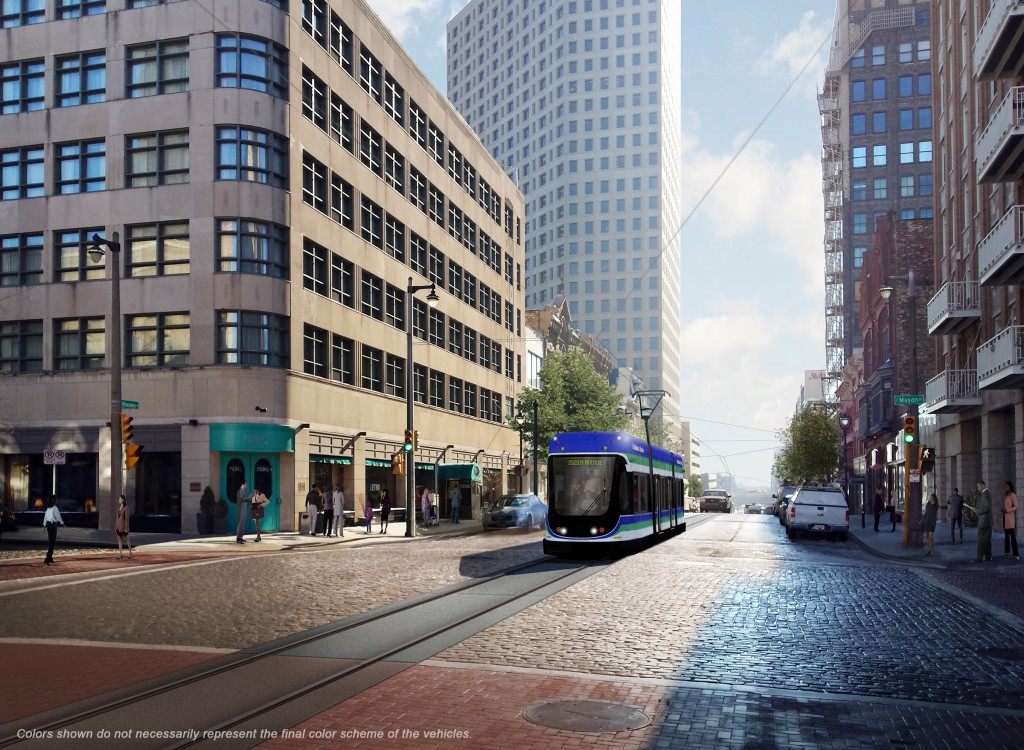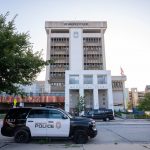Should Transit Have Dedicated Lanes?
Dedicated lanes for transit would improve speed and efficiency, but reduce auto lanes or parking.
A friend who lives in Toronto recently told me about her daily commute to work via streetcar. “It is way too expensive to park downtown near my job, and the streetcar is my best option. But it’s frustrating how long it takes to get to and from work every day.” The streetcar line she uses, like most of the 11 lines operated by the Toronto Transit Commission, operates in mixed traffic, which results in frequent delays for the system’s roughly 250,000 daily riders.
As a recent New York Times article points out, cities looking to build their first streetcar lines, including New York City, are seeking guidance from Toronto, which has the most extensive streetcar network in North America. The advice they are receiving may be relevant for Milwaukee’s planned streetcar and bus rapid transit (BRT) services as well.
Chief among Toronto’s recommendations is to provide dedicated lanes for transit whenever possible to improve speed and efficiency for riders. That is more easily said than done, however, as dedicating lanes for transit requires reducing the number of lanes available for general traffic and/or parking. The desire to improve speed and convenience for transit riders must be balanced with desires for uncongested travel lanes for drivers, maximum access to businesses along the route, and other competing priorities.
Based on the experiences of Toronto, Albuquerque (where an advanced BRT project is being developed), and countless other cities, if Milwaukee’s plans for dedicated transit lanes move forward we can expect a healthy local debate over the use of public street space – covering issues such as mobility, cost, and safety. Significant pushback from some area businesses and motorists is to be expected. On the other hand, if the services are developed without dedicated lanes, then we are likely to see complaints from transit riders and questions regarding whether the benefits provided by the services are great enough to justify the investments.
These are not easy decisions. What seems clear, however, is that speed and efficiency are important to transit users and will be a major determinant of the popularity of our new transit services. If fast and efficient services and healthy ridership are the expected results of the major transit investments we are making and planning, then dedicated transit lanes should be strongly considered.
Joe Peterangelo, a senior researcher with the Public Policy Forum.
Op-Ed
-
Wisconsin Candidates Decry Money in Politics, Plan to Raise Tons of It
 Dec 15th, 2025 by Ruth Conniff
Dec 15th, 2025 by Ruth Conniff
-
Trump Left Contraceptives to Rot; Women Pay the Price
 Dec 8th, 2025 by Dr. Shefaali Sharma
Dec 8th, 2025 by Dr. Shefaali Sharma
-
Why the Common Council’s Amended Budget is Good Policy for Milwaukee
 Nov 20th, 2025 by Alds. Marina Dimitrijevic and Russell W. Stamper, II
Nov 20th, 2025 by Alds. Marina Dimitrijevic and Russell W. Stamper, II
Transportation
-
Congestion Pricing Cuts Air Pollution in New York City
 Dec 14th, 2025 by Jeff Wood
Dec 14th, 2025 by Jeff Wood
-
FTA Tells Milwaukee to Crack Down on Fare Evasion — Even Where Fares Don’t Exist
 Dec 12th, 2025 by Graham Kilmer
Dec 12th, 2025 by Graham Kilmer
-
Will GOGO’s Bus Service Ever Get Going?
 Dec 9th, 2025 by Jeramey Jannene
Dec 9th, 2025 by Jeramey Jannene























Screw balance. If you’re spending millions on the infrastructure, go all the way or don’t build it at all. Any “balance” plays into the common sentiment that this will be a boondoggle that no one will ride. If you want riders, make it as efficient as possible at moving people.
If they’ve already resigned themselves to doing mixed traffic, then at the very least give the streetcar signal priority.
I’m always puzzled why the ‘multimodal transportation’ Lefties always seem to stop at streetcars… um, horses?? Come on!! Mixed mode… mixed species… last-century… so perfect. The dung can be shipped straight to MMSD to either churn our Milorganite, or dumped into Lake Michigan. Plus, dung collectors can be put on the city payroll. They work in all seasons, most temperatures…
Think bigger!
Ah right-wing humor. Rarely ever funny. Remember Red Eye? Exactly.
Why do you care when you live in Washington County? Milwaukee only exists to you as a place to criticize. You are free to roam about your county in your pickup truck adorned with Confederate Flag stickers and naked lady mudflaps all you like free from other modes of transportation.
Have one of the local mining equipment manufactures drill some tunnels to test their products and give this town a subway.
@WashCoRepub: The reason “lefties” and others are not pushing other forms of mass transit–oops, I forgot that folks on the other side, including our Governor, have nothing but contempt for mass transit in general, settling for fossil-fueled buses when forced to do so,albeit with drastically reduced funding–is because it is thought that streetcars are all that we can afford or get political support for. San Francisco and Boston use streetcars extensively, both in mixed traffic and on exclusive right of way. They also have both light and heavy rail, as well as buses (and limited use of electric trolley buses in Boston). Portland, Oregon, with a central city and metropolitan area roughly the size of ours has a very popular streetcar downtown, as well as a large and expanding light rail network. Metro Los Angeles has a huge light rail system that runs on streets in Long Beach. As does Salt Lake City, hardly a leftist citadel, with a direct airport connection. I know that it is verboten to mention other countries, but nevertheless, Berlin, Dusseldorf, Brussels, and Amsterdam, to name a few, use streetcars extensively. . A number of those cities have non-lefty municipal government.
Plenty of non-lefties support rail mass transit, as it takes traffic off freeways and major traffic arteries, reducing congestion and reducing the frequency of repaving and widening these roads. Milwaukee has always, at least from the early 20th century, been a conservative town, in manner of living if not in politics, and its narrow transit horizons are in keeping with this conservatism.
And no, streetcars are hardly retrograde; today’s vehicles use the latest technologies and computers. They are not the first step toward horse dung on cobblestone streets.
I know! I was conflating streetcars with light rail. This is because I did not know how I should refer to light rail vehicles that function as streetcars downtown in cities that cannot afford costly, long subway tunnels in densely settled areas…A few cities give identical vehicles this double life. Indeed, many opponents of the Milwaukee streetcar see the streetcar as the entering wedge for–heaven for fend!–light rail. Were it but so!
Get over yourself WashCounty…… Vincent is right, this doesn’t concern you. It’s about time Milwaukee does what’s right for Milwaukee. You can worry about whether or not people paint their homes the right color or whether or not they have the correct mailboxes. We have bigger fish to fry. You’re on the wrong side of history….. it’s over WashCounty. Time to get out of the way. Btw…. your post was stupid. It really was…. I’m giving you constructive criticism.
I also agree that the BRT needs to be done right. Dedicated lanes are crucial. Just think of the destination that’ll be connected. Not only does this corridor bisect the region with the highest population in the state, but it also connects the lakefront, downtown, MU, Harley, Miller, Miller Park, the zoo, St. Camillus, Milw Regional Med Center, Innovation Park, Mayfair…… AND…… Waukesha County.
Furthermore, BRT will make the entire bus system more effective and efficient. Local bus service will feed the regional system. If Alderman Bauman and Murphy are reading this, please do what you can to make this work. Im afraid they will water the plan down to the point that it won’t make sense. We need courage in leadership.
Dedicated lanes for transit are vitally important in the most congested areas – especially through downtown for the East-West BRT proposal. For a true BRT project, there should be dedicated lanes along nearly the entire route, other than perhaps a few short stretches with little to no congestion – otherwise it’s just regular BT (bus transit).
Frankly, it’s absurd that there are not already dedicated transit lanes running east-west through downtown right now. There is more than enough bus traffic on the existing bus routes to justify them. Even if the current BRT plans fall apart, the city should still install dedicated transit lanes through downtown.
Hate to say it, but making travel around Milwaukee and reducing parking will increase the ridership on mass transit of any type. That is why it works in the big cities. When downtown workers start paying more than $20 per day for parking, then they will start looking for alternatives. As a former bus rider, my biggest issue with the buses are the long travel times. Too many stops. Dedicated lanes is the only way to go wherever possible.
Casey says “… give this town a subway.”
The idea was floated to the public back in the 1910s-20s with cut-away drawings in the daily press. The plan showed lines running parallel to the river – on both sides. The idea probably caused heart seizures all across Milwaukee County.
I can’t post a link here to articles prev. available at the dear, departed, free Google site … Yance Marti might have them archived at his http://oldmilwaukee.net/blog/
Subways are extremely expensive. New York City is building a new (“Second Avenue”) subway. It will be just over 1.5 miles long with 3 new stations plus the expansion of an existing station (where the new subway meets an existing subway).
The cost of these 1.5 miles? About $4.5 billion (yes, with a “b”), or around $3,000 million per mile!
It’s not a new idea, dedicated lanes. It has always been part of the program except shopkeepers protest losing parking in front of their place. Without them streetcars create more congestion than they solve. Dramatically cuts down on their efficiency which is the most important consideration between modes of transportation.
There should be dedicated lanes for the streetcar and BRT. All the way.